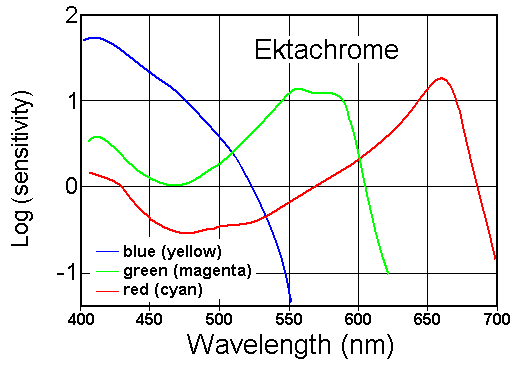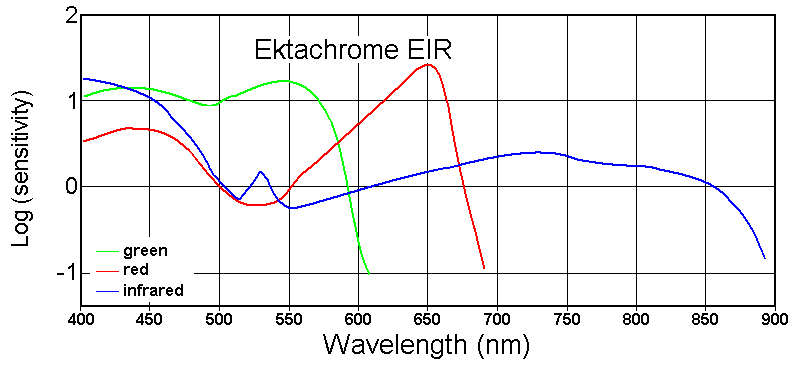Home Sensing Primer Glossary Physics Related Technologies Acknowledgements
Emulsion: A Physical Storage Medium
To understand remote sensing data, we must understand how they are stored. Also, we must understand some crucial details about
bandwidths and spectral ranges. So we begin with something frequently derided as "old school", that is, film.
Do not pooh-pooh film--it has some excellent attributes.
A major benefit of photographic emulsion is its extremely high resolution. The photosensitive grains in film can resolve
detail at 50-100 lines per mm. On 35 mm film, this translates to an effective image size (in pixels) of up to 2400 x 3600, i.e. 8.6 million
pixels (more about "image size" in the next section). This is comparable to the image sizes of the top of the line digital
cameras being offered by Nikon and Kodak in 2004, although the 2004 prices of such cameras are US$1500-5000.
Film emulsions have inherent bandwidths over which they are sensitive; these bandwidths
are determined by the physical properties of the film (bandwidths are discussed more later). Cameras using black and white films are
typically sensitive to photons in the range 400-650 nm. Color film has three or four emulsion layers sandwiched together; the sensitivity
curves of the three layers in Kodak Ektachrome color film are shown below. These bandwidths may be further modified by the properties
of the glass or plastic camera lenses in the camera, and any filters selected by the user.

Sensitivity curves of the emulsion layers in Ektachrome color film.
(Figure redrawn from data provided on www.kodak.com.)
Color film is usually designed to render realistic, color-accurate images. So, for example, red-colored photons landing on
the emulsion should result in a red image in the final image. Similarly, green photons absorbed by the emulsion should result in a green
image, and blue-wavelength photons should result in a blue image. When the colors in the final image accurately correspond to the
colors of the detected photons, the result is said to be a "true color image."
Note that black and white film can be used to take color photographs. This is done by taking three separate black and white
images--where each image was recorded using an appropriate color filter in the camera system--and combining the three images in the darkroom
or on the computer.
Not all films are engineered to have bandwidths that correspond to visible light. Commercially available color infrared film
is sensitive to photons with wavelengths as long as nearly 1000 nm. For example, the infrared-sensitive emulsion of Ektachrome EIR film
can detect photons as long as 900 nm.

Sensitivity curves of the emulsion layers in Ektachrome infrared film.
(Figure redrawn from data provided on www.kodak.com.)
The results of color infrared film can look strange because the images are not true color (the color of the photons
detected by each band is not represented by that color in the final photograph). The infrared energy (which is normally invisible to
human eyes) is represented on the finished photograph as red. Meanwhile, red photons detected by the film are represented by green on the
finished photograph, and green photons are represented by blue. Because of these transformations, a green ball and a red ball photographed
in color infrared film would look like a blue ball and a green ball, respectively. A blue ball would not register at all (the film is not sensitive
to blue light), but one reflecting IR radiation produced by an IR light source would look red!
To explain the colors more thoroughly, consider the graphic of the balls shown below. In this simplified situation, the
three balls are sitting on a white plane (i.e. a surface that reflects all colors equally), and are illuminated by white, optical
wavelength radiation. The three balls, from rear to front, absorb all optical radiation except for red, blue, and green radiation
respectively. On the left, the true color image of the situation as recorded by color film appears normal. The graphic on
the right shows the image results using IR film: The red ball is rendered green, the green ball is rendered blue, and the blue ball is
invisible because the only radition it reflects (blue) is not recorded by the film. The presence of the blue ball can be inferred,
however, by its black obscuring surface. Note that the incident radiation reflected from the white background would be displayed as cyan. In
understanding these translations, it may be helpful to review the chart on color addition shown here
(if you follow that link, use your browser's "BACK" button to return to this page).

Color images made by using these kinds
of color conversions are called false color images. False color images from color IR film have immediate applications in remote sensing
because different vegetation types reflect infrared radiation differently. Healthy vegetation usually looks magenta-red, while diseased
trees may look dark red, green, or even yellow.
Special procedures must be followed when using color infrared film. For example, with Ektachrome EIR, a yellow filter must
be used to eliminate blue photons (which would fog all three emulsion layers), and the film must be refrigerated before and after being
exposed.